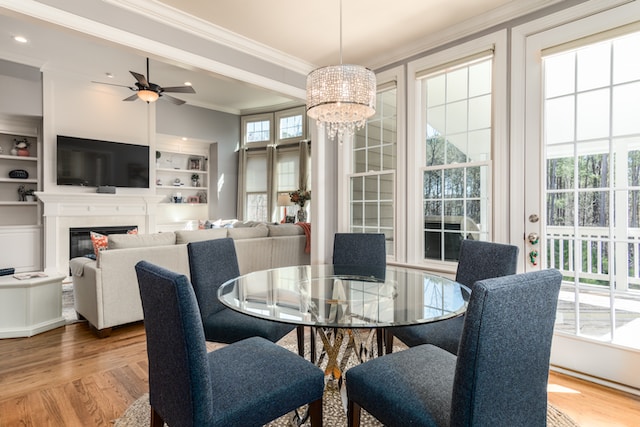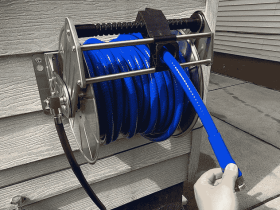Energy efficiency has become a buzzword of the 21st century and one of the standards by which potential homebuyers judge the value of modern homes. With most people seeking to waste less and save more money while caring for Mother Earth, there is a lot you can do to create big savings and lower carbon footprints at home. Here are the 10 easy ways to make your home more energy-efficient.
1. Test and Change Windows and Doors
You might be wasting energy during your heating and cooling session at home if your windows and doors lack airtight seals or are damaged. Test all the doors and windows for drafts by holding a lit candle close to them and watching for flickers. Seal drafty sections using weather stripping, draft excluder, tape, or caulk.
If your home still has single-glazed windows, consider replacing them with one of the energy-efficient options. Some primary window improvement and replacement options are double-glazing, triple-glazing, and secondary-glazing, which works best for rental homes.
2. Add Insulation to Your Flooring Roof and Loft
A notable percentage of your home’s heat escapes via the ground floor, walls, roof, and the loft. Proper insulation in the loft is crucial, and for easier access during maintenance or inspection, consider installing a BA-DW-5058-58 recessed access door. Remember, your flooring type is key to selecting the right floor insulation. For instance, insulating tiled flooring and solid floors made of concrete or stone may involve setting up a layer of rigid thermal insulating boards on the top of the floor.
To insulate rooms with suspended floorings, you can use spray foam insulation, a type of mineral wood, or rigid boards. About 270mm of loft insulation can go a long way in preventing energy loss through the loft and roof.
3. Install Solar Panels
While the initial cost of solar panel installation can be high, it is among the most effective ways of creating an energy-efficient home. The installation cost varies based on where you live and the number of solar panels you want to install. On average, the panels cost between $4500 and $36,000.
With a robust solar energy system, you could save an estimated $1500 each year while greatly lowering carbon footprint and fossil fuel’s adverse environmental effects. Most solar panels last 25 to 30 years before starting to lose efficiency. This means you will have many years of savings on energy costs.
4. Automate Usage
You can reduce heating and cooling costs by 15% by installing a smart thermostat. Smart thermostats study your habits to adjust temperatures automatically. One of its best features is the ability to switch off the heating and cooling system automatically when you leave home and back on immediately after you return.
You can control your smart thermostat using your phone from anywhere and schedule changes. Consider automating lighting by installing smart switches, motion sensors, and dimmer switches.
5. Take Care of Your Furnace
While the new high-efficiency furnaces consume a minimal amount of energy, you can still make an older model more energy-efficient. The first step is to undertake an annual servicing by a professional. It will include thorough cleaning of the parts you can’t reach to ensure it is not straining to run efficiently. Replace filters regularly after three months or sooner if you have pets to prolong the furnace’s life and ensure air moves swiftly.
6. Don’t Leave Devices and Appliances on Standby
Did you know standby power loads account for about 5% to 10% of residential energy use? An average U.S. household could spend up to $100 per year for not unplugging appliances when not in use. So long as the appliances are plugged in, they quietly drain electricity even when turned off.
You can minimize standby power loads and save money by unplugging products where possible. Consider plugging your appliances in a surge protector power strip with switches and use Energy Star products with lower standby power.
7. Invest in Energy Efficient Appliances
If you have been using your appliances for more than 10 years, they are most likely using more energy than new models. Newer appliances feature more energy-efficient advanced technologies with better motors, improved insulation, and more efficient cooling and heating systems. They also have design improvements, which include smarter control mechanisms.
Besides, most countries have established energy efficiency regulations and standards. Manufacturers ensure that newer appliances meet these standards to operate at peak efficiency. When shopping around for new appliances, go for Energy Star Certified ones.
8. Install Tankless Water Heater
Demand or tankless water heaters only provide hot water when the need arises and warm the water directly with no storage tank. This helps eliminate the standby energy losses linked to traditional storage water heaters, saving on energy costs.
Once you turn on a hot water tap, cold water flows through the pipe, entering the unit. An electric element heats the water instantly, giving you access to a constant hot water supply. The good thing about tankless water heaters is that they eliminate the need to fill a storage tank with enough hot water before use.
9. Go for Darker Drapes
Perhaps you might have noticed certain rooms in the house being hotter than others, or there is a need to run the air conditioner longer in one room compared to others. The sun might be having a greater impact on that particular room.
Investing in blackout curtains can help you cool down the room without necessarily keeping the AC constantly running all day. The shades keep the light out by darkening the room and helping cool the space before bedtime.
10. Consider LED Bulbs
Substituting traditional bulbs with LED light bulbs can make a difference in creating an energy-efficient home. The bulbs come in an array of wattages, shapes, temperatures, and colors, packing a major energy-saving punch.
LED bulbs emit light in a specific direction, eliminating the need for reflectors and diffusers. This makes these lights stand out in efficiency than their traditional counterparts. Typically, LEDs consume 75% less power compared to incandescent lighting and have a longer lifespan.
Conclusion
It’s never too late to take steps to enhance your home’s energy efficiency. Hire a professional to perform an energy audit, or do it yourself for free. It will help highlight areas where you use more energy and determine which improvements to make from this list to increase savings. Always unplug devices and appliances when not in use and seal drafty sections of your house to minimize energy loss.











Leave a Review